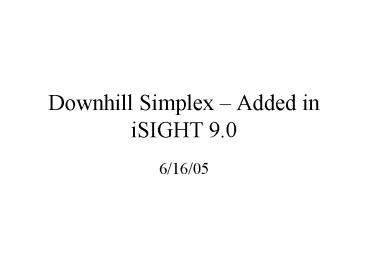Downhill Simplex Added in iSIGHT 9'0 PowerPoint PPT Presentation
1 / 23
Title: Downhill Simplex Added in iSIGHT 9'0
1
Downhill Simplex Added in iSIGHT 9.0
- 6/16/05
2
References
- Outstanding paper Optimization Methods for Base
Station Placement in Wireless Applications.
Margaret Wright. www.bell-labs.com/org/wireless/w
isepub/vt98_mhw.pdf - Optimization Concepts and Applications in
Engineering. Belegundu and Chandrupatila. 1999.
Prentice Hall. - Engineering Optimization Theory and Practice.
Singiresu Rao. 1996. John Wiley and Sons. - Optimization in Operations Research. Ronald
Rardin. 1998. Prentice Hall.
3
iSIGHT Diagnostics
- None
- Recommend multiple point restart
- Do not make initial step size too small.
- Needs to have explicit bounds set on design
variables in iSIGHT
4
Characteristics
- O order search technique. No gradients
- Works on non smooth landscapes
- Most widely used of direct search techniques
(e.g. Hooke Jeeves) - Wright states has solved tens of thousands of
problems. - Needs a penalty function formulation.
- Almost no tuning parameters. Parameters used and
their values universally accepted.
5
Characteristics
- Need n1 vertices
- 4 Possible operations
- Reflection
- Expansion
- Contraction
- Shrinkage (rarely invoked)
6
Simplex 3D Visualization Concept
7
Reflection
8
Reflection Process
9
Reflection, Expansion and Contraction
10
Scaling or Shrinkage
11
Algorithm
Key Tuning Parameters Reflection 1 Expansion
2 Contraction .5 Shrinkage .5
12
(No Transcript)
13
(No Transcript)
14
Iteration
- Each iteration
- New vertex generated. If accepted replaces worse
vertex. - If not accepted, shrink with new set of best
point n new points - Typically only one or two function evaluations
per iteration
15
Termination Criteria
Maximum Function Change at Vertices lt .001 Or
Number of Iterations
16
Spring Formulation
Note Need for lower and upper bounds on
design variables
17
Basic Tuning Parameters
18
No Advanced Parameters
19
Final Solution
20
Zero Diagnostics in Log File
21
Walkthrough
22
Downhill Simplex Lab
- Rerun the Spring_Start.desc file using Downhill
Simplex with the default step size and upper and
lower bounds on design variables of -10 and 10
for X1 and X2. - Does it reach the same optimum?
- How many function calls did it take?
- Is this more or less efficient then Hooke Jeeves?
- Why is this comparison unfair?
- Since there are no diagnostics and to demonstrate
your knowledge of the algorithm for self
diagnostics, on the next slide, label the
algorithm step number from slides 12 and 13 next
to each row for the first 10 rows. Remember row1
never counts as iSIGHT evaluates base point
before invoking optimizer.
23
Spring Problem Self Diagnostics

